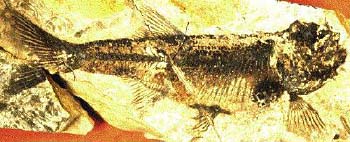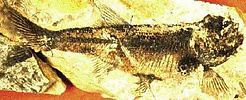Eohiodon
Guo-Qing Li and Mark V. H. Wilson
Introduction
The first known fossil hiodontiform genus, †Eohiodon, was named by Cavender in 1966 based on a review of "†Leuciscus" rosei Hussakof (1916). Since then, three North American species, all of Eocene age, have been included in this genus. The type species †Eohiodon rosei (Hussakof) is known from the Tranquille beds near Kamloops, the Allenby Formation near Princeton, and the Horsefly beds near Horsefly, British Columbia, Canada (Wilson, 1974, 1977, 1978). †Eohiodon woodruffi Wilson 1978 has been found in the Klondike Mountain Formation near Republic, Washington, USA, as well as in the Horsefly beds near Horsefly, British Columbia. †Eohiodon falcatus Grande 1979 is known from the Fossil Butte Member of the Green River Formation, Lincoln County, Wyoming, USA (Grande 1984). Recent studies (Li, Wilson, and Grande 1997) suggest that †Eohiodon falcatus is a junior synonym of †Eohiodon woodruffi (see Comparison among Species of Eohiodon).
Characteristics
†Eohiodon differs from other genera in the Hiodontiformes mainly in the following features:
- Hyomandibular bone with three equal-sized dorsal parts (two cranial and one opercular process).
- Total vertebral centra 44-50 (consisting of 22-24 precaudal vertebral centra and 23-26 caudal vertebral centra).
- Principal dorsal-fin rays 11-15.
- Dorsal pterygiophores (dorsal proximal radials) 13-17.
- Principal anal-fin rays 14-24.
- Anal pterygiophores (anal proximal radials) 16-25.
Comparison among Species of Eohiodon
Grande (1979) named ![]() Eohiodon falcatus based on specimens from the Green River Formation of Wyoming. Recent study of new specimens of both
Eohiodon falcatus based on specimens from the Green River Formation of Wyoming. Recent study of new specimens of both ![]() Eohiodon woodruffi and
Eohiodon woodruffi and ![]() Eohiodon falcatus indicates that the two species are indistinguishable in the vast majority of characters, particularly in preserved cranial skeletal features (Li, Wilson, and Grande, 1997). In addition, the falcate median fins that define
Eohiodon falcatus indicates that the two species are indistinguishable in the vast majority of characters, particularly in preserved cranial skeletal features (Li, Wilson, and Grande, 1997). In addition, the falcate median fins that define ![]() Eohiodon falcatus are not much different from those in specimens of
Eohiodon falcatus are not much different from those in specimens of ![]() Eohiodon woodruffi; the size (standard length) at maturity (estimated by the occurrence of the sexually dimorphic anal-fin in males) is about the same (~100 mm SL). It appears that there are only two consistent differences between the two nominal species: 1) principal anal-fin rays in specimens referred to
Eohiodon woodruffi; the size (standard length) at maturity (estimated by the occurrence of the sexually dimorphic anal-fin in males) is about the same (~100 mm SL). It appears that there are only two consistent differences between the two nominal species: 1) principal anal-fin rays in specimens referred to ![]() Eohiodon falcatus number 1-4 more than in
Eohiodon falcatus number 1-4 more than in ![]() Eohiodon woodruffi; and 2)
Eohiodon woodruffi; and 2) ![]() Eohiodon falcatus specimens may have 1-4 more anal pterygiophores than
Eohiodon falcatus specimens may have 1-4 more anal pterygiophores than ![]() Eohiodon woodruffi. These differences in the anal-fin appear not to be correlated to overall meristic counts, even though Li and Wilson (1994) reported that anal-fin meristics are correlated with number of vertebral centra in other hiodontid species. In fact, specimens of both
Eohiodon woodruffi. These differences in the anal-fin appear not to be correlated to overall meristic counts, even though Li and Wilson (1994) reported that anal-fin meristics are correlated with number of vertebral centra in other hiodontid species. In fact, specimens of both ![]() Eohiodon falcatus and
Eohiodon falcatus and ![]() Eohiodon woodruffi have about the same number of vertebrae (Li, Wilson, and Grande 1997: table 2). The difference in anal-fin elements is not considered sufficient to justify separate species (Li, Wilson, and Grande, 1997), and
Eohiodon woodruffi have about the same number of vertebrae (Li, Wilson, and Grande 1997: table 2). The difference in anal-fin elements is not considered sufficient to justify separate species (Li, Wilson, and Grande, 1997), and ![]() Eohiodon falcatus is here treated as a junior synonym of
Eohiodon falcatus is here treated as a junior synonym of ![]() Eohiodon woodruffi.
Eohiodon woodruffi.
As regards the main difference between ![]() Eohiodon and Hiodon, Cavender (1966) and Wilson (1978) made preliminary comparisons mainly in meristics among
Eohiodon and Hiodon, Cavender (1966) and Wilson (1978) made preliminary comparisons mainly in meristics among ![]() Eohiodon rosei,
Eohiodon rosei, ![]() Eohiodon woodruffi, and the two extant Hiodon species. Grande (1979) pointed out some differences among (nominal)
Eohiodon woodruffi, and the two extant Hiodon species. Grande (1979) pointed out some differences among (nominal) ![]() Eohiodon falcatus,
Eohiodon falcatus, ![]() Eohiodon rosei, and the two extant Hiodon species. Li, Wilson, and Grande (1997) recently confirmed that
Eohiodon rosei, and the two extant Hiodon species. Li, Wilson, and Grande (1997) recently confirmed that ![]() Eohiodon woodruffi resembles
Eohiodon woodruffi resembles ![]() Eohiodon rosei but differs from Hiodon in having fewer total vertebrae, fewer principal anal-fin rays, fewer anal pterygiophores, more principal dorsal-fin rays, and more dorsal pterygiophores (see Li, Wilson, and Grande, 1997: tables 2, 3).
Eohiodon rosei but differs from Hiodon in having fewer total vertebrae, fewer principal anal-fin rays, fewer anal pterygiophores, more principal dorsal-fin rays, and more dorsal pterygiophores (see Li, Wilson, and Grande, 1997: tables 2, 3).
References
Cavender, T. 1966. Systematic position of the North American Eocene fish, "Leuciscus" rosei Hussakof. Copeia, 1966:311-320.
Grande, L. 1979. Eohiodon falcatus, a new species of hiodontid (Pisces) from the late early Eocene Green River Formation of Wyoming. Journal of Paleontology, 53:103-111.
Grande, L. 1984. Paleontology of the Green River Formation, with a review of the fish fauna. The Geological Survey of Wyoming, Bulletin 63, 334 p. (2nd ed.).
Hussakof, L. 1916. A new cyprinid fish Leuciscus rosei from the Miocene of British Columbia. American Journal of Science, 42:18-20.
Li G.-Q. Mark V. H. Wilson, and L. Grande. 1997. Review of Eohiodon (Teleostei: Osteoglossomorpha) from western North America, with a phylogenetic reassessment of Hiodontidae. Journal of PALEONTOLOGY, 71: 1109-1124.
Wilson, M. V. H. 1974. Fossil fishes of the Tertiary of British Columbia. Unpubl. Ph.D. dissertation, University of Toronto, Canada, 375 p.
Wilson, M. V. H. 1977. Middle Eocene freshwater fishes from British Columbia. Life Sciences Contributions, Royal Ontario Museum, 113:1-61.
Wilson, M. V. H. 1978. Eohiodon woodruffi n. sp. (Teleostei, Hiodontidae) from the middle Eocene Klondike Mountain Formation near Republic, Washington. Canadian Journal of Earth Sciences, 15:679-686.
About This Page

Chinese Academy of Sciences, Beijing , China

University of Alberta, Edmonton, Alberta, Canada
Correspondence regarding this page should be directed to Guo-Qing Li at
Page copyright © 1998 and
All Rights Reserved.
Citing this page:
Li, Guo-Qing and Mark V. H. Wilson. 1998. Eohiodon. Version 01 January 1998. http://tolweb.org/Eohiodon/15138/1998.01.01 in The Tree of Life Web Project, http://tolweb.org/










 Go to quick links
Go to quick search
Go to navigation for this section of the ToL site
Go to detailed links for the ToL site
Go to quick links
Go to quick search
Go to navigation for this section of the ToL site
Go to detailed links for the ToL site